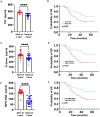Neutrophil Extracellular Traps Enhance Procoagulant Activity and Predict Poor Prognosis in Patients With Metastatic Breast Cancer
- PMID: 40062357
- PMCID: PMC11890004
- DOI: 10.2147/IJGM.S511024
Neutrophil Extracellular Traps Enhance Procoagulant Activity and Predict Poor Prognosis in Patients With Metastatic Breast Cancer
Abstract
Objective: Neutrophil extracellular traps (NETs) are associated with poor prognosis and an increased risk of venous thromboembolism (VTE) in metastatic breast cancer (MBC). This study aims to determine whether NETs promote hypercoagulability and if NETs and plasma hypercoagulability markers are biomarkers of survival in MBC.
Methods: Circulating levels of neutrophil extracellular trap (NET) markers and hypercoagulability markers (TAT, fibrinogen, and D-dimer) were assessed in 112 MBC patients before treatment, compared to 55 healthy controls. Stratified by NET levels and plasma TAT, fibrinogen, and D-dimer, the correlation with overall survival was analyzed. The NET procoagulant activity was evaluated using fibrin and purified coagulation complex production assays, and by measuring coagulation time (CT).
Results: MBC patients exhibited significantly elevated plasma NET levels compared to healthy controls (all P<0.05), circulating MPO-DNA and NE-DNA levels were positively correlated with plasma TAT, fibrinogen, D-dimer, CT, FVIIIa, and platelet (PLT) counts. Additionally, we observed a significant increase in NETs formation in control neutrophils exposed to MBC plasma compared to those exposed to control plasma. NETs from MBC neutrophils significantly increased the potency of control plasma to generate thrombin and fibrin, effects that were notably attenuated by DNase I. Plasma TAT and D-dimer levels were significantly higher in MBC patients who died within three years post-recruitment compared to those who survived beyond three year. Plasma TAT and D-dimer were inversely correlated with survival. High plasma levels of MPO-DNA were associated with significantly worse overall survival (HR: 2.445, 95% CI: 1.255-4.762, P=0.007). MBC patients with both high D-dimer and high MPO-DNA had significantly reduced survival (HR: 2.450, 95% CI: 1.332-4.488, P=0.002).
Conclusion: Our results highlight the increased release of NETs in MBC patients and reveal that NET formation enhances hypercoagulability and cancer progression. Targeting NETs may be a potential therapeutic strategy to inhibit MBC progression and mitigate thrombotic complications in MBC.
Keywords: hypercoagulability; metastatic breast cancer; neutrophil extracellular traps; procoagulant activity; prognosis.
© 2025 Gong et al.
Conflict of interest statement
The authors have no conflicts of interest to declare for this work.
Figures





Similar articles
-
Circulating tumour cells and hypercoagulability: a lethal relationship in metastatic breast cancer.Clin Transl Oncol. 2020 Jun;22(6):870-877. doi: 10.1007/s12094-019-02197-6. Epub 2019 Aug 31. Clin Transl Oncol. 2020. PMID: 31473984 Free PMC article.
-
Procoagulant role of neutrophil extracellular traps in patients with gastric cancer.Int J Clin Exp Pathol. 2015 Nov 1;8(11):14075-86. eCollection 2015. Int J Clin Exp Pathol. 2015. PMID: 26823721 Free PMC article.
-
Interactions between neutrophil extracellular traps and activated platelets enhance procoagulant activity in acute stroke patients with ICA occlusion.EBioMedicine. 2020 Mar;53:102671. doi: 10.1016/j.ebiom.2020.102671. Epub 2020 Feb 27. EBioMedicine. 2020. PMID: 32114386 Free PMC article.
-
PO-31 - Circulating tumour cells and hypercoagulability: a lethal relationship in metastatic breast cancer.Thromb Res. 2016 Apr;140 Suppl 1:S188. doi: 10.1016/S0049-3848(16)30164-5. Epub 2016 Apr 8. Thromb Res. 2016. PMID: 27161721
-
Neutrophil Extracellular Traps (NETs) and Hypercoagulability in Plasma Cell Dyscrasias-Is This Phenomenon Worthy of Exploration?J Clin Med. 2021 Nov 11;10(22):5243. doi: 10.3390/jcm10225243. J Clin Med. 2021. PMID: 34830525 Free PMC article. Review.
References
-
- Dewilde S, Lloyd A, Holm M, Lee A. Quality of life of patients experiencing cancer-associated thrombosis. Value Health. 2015;18(7):A397–A398. doi:10.1016/j.jval.2015.09.906 - DOI
LinkOut - more resources
Full Text Sources
Research Materials
Miscellaneous

